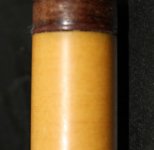Hi,
I have received many PMs concerning this Micarta thread and I just got one this morning from a gentlemen who forwarded me a PDF concern the history of Micarta an the revolution that occurred from plastics in manufacturing in the 20th century.
There was nothing about "asbestos" in the 3 page document as it did not go into the different formulations or chemistry concerning the product. Here is a paragraph I cut and pasted that is germaine to the subject that has been argued here.
In 1913, Daniel O’Conor, head of the research engineering, process section, and Herbert Faber, insulating materials sales manager, left Westinghouse to found The Formica Insulation Corporation because of disagreements on how to market this product. General Electric also became an early manufacturer of these thermosetting plastics. There were many patents and law suits in the 1918 – 1927 time frame involving Westinghouse, Formica, General Electric, Bakelite, and others. Westinghouse and General Electric had forced Bakelite not to sell phenolic resin to Formica. With the expiration of some patents, court rulings, licensing agreements, the combining of several resin companies into Bakelite Corporation (later became part of Union Carbide), and the increased demand for these products and in the end as a settlement, Westinghouse licensed Formica, GE, and others to make these materials. Several other companies including Panelyte, Taylor Fibre Company, and Continental Diamond Fibre Company entered the industrial high pressure thermosetting laminate market. Applications for these products are for insulating electrical equipment.
So Wikepedia's description failed to give vital details concern the marketing application, legal issues and general historical info regarding something that was revolutionary in products that changed the culture in manufacturing. Single sourcing information to validate a point of contention can often cause knee jerk reactions that can hide the real facts. The fact that Micarta was a trade name had nothing to due with it's proliferation in the market and the Micarta became an icon like Kleenex or Xerox did concerning a product association. This was my point of contention since my first post and it saddens me that stipulating a few points could cause such personal character attacks. I guess at a time like that we are all naked at the alter of the truth. Which I must say is sometimes flawed by urban legend. That's why you always have to do you homework and research and not be swayed by any venom that may come your way
Also, my very good friend and cue maker in my midwest area Todd Schaller has been following this thread and gave me a ferrule cut off of a shaft from the Omega DPK shop in Wacanda Il.. Todd has over 20 of these but more importantly is that he had the opportunity to pick up all of the stock materials left in that shop for making cues when the realtor was going to dumpster everything to clear the space.
Todd has pieces of the flat laminate sheets that have the Westinghouse lable still on them. Since DPK was the person who set up the Omega DPK Shop, I think it is a safe bet that this material is the same stuff the Jerry Franklin had been using. But don't quote me because it is only my deduction from the evidence. I could not swear to this on the stand.
The ferrule pics below are of the same material and if you inspect it closely it is the same stuff that has been shown here in another post. The other very yellow stuff is a different formula or is from a different manufacturer as well as the GE stuff I have posted.
There are many many formulas but I think the question is which ones have the secrete sauce in their formula called "asbestos". I don't know for sure but I would bet the asbestos is the reason those ferrules have such an impact concerning playability on a cue.
Thanks for all of the positive thoughts from people who contacted me about this thread. It is appreciated very much.
To everyone here, it's all good and enjoy the holiday weekend,
Rick
Westinghouse Micarta from the Omega DPK cue making material stores.


I just ran across this post as I quit monitoring this thread after my last post as it is futile trying to get a point across with someone who believes he knows all. However these two pictures are real old yellow Micarta as near as I can tell without having them in my hand. One question. Why is it that there is no flat laminates visible in these two ferrules? Have they been Photo shopped out? Have they been erased? Or, could it be that they were cast into thick sheets from an emulsion and then reworked into what ever forms that were desired as I tried to convince all earlier and not formed in layered sheets like phenolic is. Inquiring minds want to know.
Dick
